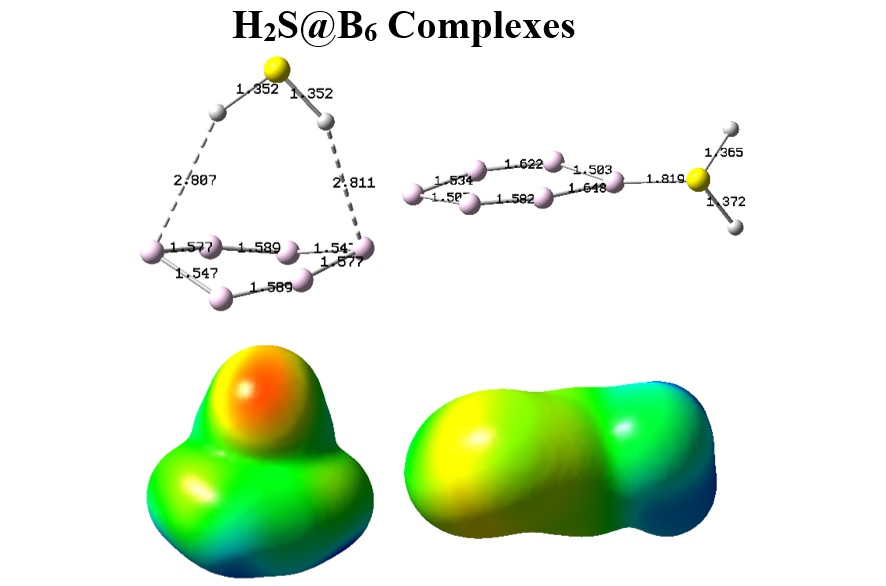Computational Investigation of B6 Particle for H2S Capturing
DOI:
https://doi.org/10.22034/advjscieng21021031Keywords:
Boron-6, Particle, Hydrogen sulfide, DFT, Gas capturingAbstract
Hydrogen sulfide (H2S) hazardous gas capturing by a model of boron-6 (B6) cyclic particle was investigated in this work using computational methodology. To this aim, density functional theory (DFT) calculations were performed to obtain optimized geometries of individual H2S and B6 counterparts in addition to their complex systems. Two sides of H2S including H and S sides were located towards the B6 surface to explore gas capturing through H@B6 and S@B6 interacting complex formations. Interestingly, serious differences were observed for the complexes with more stability for S@B6 complex formation in comparison with H@B6. Indeed, that of S@B6 was almost a chemisorption in contrast with that of physisorption of H@B6 complex. Further analyses based on the obtained molecular descriptors described various features of complex models in details. This work was done actually for proposing small B6 cyclic particle for H2S capturing regarding the importance of environmental issues for humankind health care.
References
Gopalan AI, Lee JC, Saianand G, Lee KP, Sonar P, Dharmarajan R, Hou YL, Ann KY, Kannan V, Kim WJ. Recent progress in the abatement of hazardous pollutants using photocatalytic TiO2 – based building materials. Nanomaterials. 2020;10:1854.
Guo S, Yang D, Zhang S, Dong Q, Li B, Tran N, Li Z, Xiong Y, Zaghloul ME. Development of a cloud?based epidermal MoSe2 device for hazardous gas sensing. Advanced Functional Materials. 2019;29:1900138.
Zahedi H, Yousefi M, Mirzaei M. DFT investigation of AlP-doped BN nanotube for CO gas capturing. Lab-in-Silico. 2020;1:38-43.
Tang X, Du A, Kou L. Gas sensing and capturing based on two?dimensional layered materials: overview from theoretical perspective. Wiley Interdisciplinary Reviews. 2018;8:1361.
Abd AA, Naji SZ. Comparison study of activators performance for MDEA solution of acid gases capturing from natural gas: Simulation-based on a real plant. Environmental Technology & Innovation. 2020;17:100562.
Koroviaka Y, Pinka J, Tymchenko S, Rastsvietaiev V, Astakhov V, Dmytruk O. Elaborating a scheme for mine methane capturing while developing coal gas seams. Mining of Mineral Deposits. 2020;14:21-27.
Iranimanesh A, Yousefi M, Mirzaei M. DFT approach on SiC nanotube for NO2 gas pollutant removal. Lab-in-Silico. 2021;2:38-43.
Rad AS, Mirabi A, Peyravi M, Mirzaei M. Nickel-decorated B12P12 nanoclusters as a strong adsorbent for SO2 adsorption: quantum chemical calculations. Canadian Journal of Physics. 2017;95:958-962.
Liang Q, Nie X, Du W, Zhang P, Wan L, Ahuja R, Ping J, Qian Z. First-principles exploration of hazardous gas molecule adsorption on pure and modified Al60N60 nanoclusters. Nanomaterials. 2020;10:2156.
Sun Y, Zhao Y, Yuan L. Impact of coal composition and pore structure on gas adsorption: a study based on a synchrotron radiation facility. Greenhouse Gases. 2020;10:116-129.
Ariaei S, Basiri H, Ramezani M. Selective adsorption function of B16C16 nano-cage for H2O, CO, CH4 and NO2. Advanced Journal of Chemistry B. 2020;2:18-25.
Kaviani S, Shahab S, Sheikhi M. Adsorption of alprazolam drug on the B12N12 and Al12N12 nano-cages for biological applications: a DFT study. Physica E. 2021;126:114473.
Aramideh M, Mirzaei M, Khodarahmi G, Gülseren O. DFT studies of graphene-functionalised derivatives of capecitabine. Zeitschrift für Naturforschung A. 2017;72:1131-1138.
Mirzaei M, Gulseren O. DFT studies of CNT–functionalized uracil-acetate hybrids. Physica E. 2015;73:105-109.
Harismah K, Ozkendir OM, Mirzaei M. Lithium adsorption at the C20 fullerene-like cage: DFT approach. Advanced Journal of Science and Engineering. 2020;1:74-79.
Mirzaei M. Uracil-functionalized ultra-small (n, 0) boron nitride nanotubes (n= 3–6): computational studies. Superlattices and Microstructures. 2013;57:44-50.
Molaeian M, Davood A, Mirzaei M. Non-covalent interactions of N-(4-carboxyphenyl) phthalimide with CNTs. Advanced Journal of Chemistry B. 2020;2:39-45.
Wang Y, Wang Z, Pan J, Liu Y. Removal of gaseous hydrogen sulfide using Fenton reagent in a spraying reactor. Fuel. 2019;239:70-75.
Paul BD, Snyder SH, Kashfi K. Effects of hydrogen sulfide on mitochondrial function and cellular bioenergetics. Redox Biology. 2021;38:101772.
Frisch MJ, Trucks GW, Schlegel HB, Scuseria GE, Robb MA, Cheeseman JR, et al. Gaussian 09 D.01 Program. Gaussian. Inc.: Wallingford, CT, USA. 2009.
Mirzaei M, Gulseren O. DFT studies of CNT–functionalized uracil-acetate hybrids. Physica E. 2015;73:105-109.
Ozkendir OM, Gunaydin S, Mirzaei M. Electronic structure study of the LiBC3 borocarbide graphene material. Advanced Journal of Chemistry B. 2019;1:37-41.
Yamali C, Gul HI, Ece A, Bua S, Angeli A, Sakagami H, Sahin E, Supuran CT. Synthesis, biological evaluation and in silico modelling studies of 1,3,5-trisubstituted pyrazoles carrying benzenesulfonamide as potential anticancer agents and selective cancer-associated hCA IX isoenzyme inhibitors. Bioorganic chemistry. 2019;92:103222.
Dizdaroglu Y, Albay C, Arslan T, Ece A, Turkoglu EA, Efe A, Senturk M, Supuran CT, Ekinci D. Design, synthesis and molecular modelling studies of some pyrazole derivatives as carbonic anhydrase inhibitors. Journal of Enzyme Inhibition and Medicinal Chemistry. 2020;35:289-297.
Farahbakhsh Z, Zamani MR, Rafienia M, Gülseren O, Mirzaei M. In silico activity of AS1411 aptamer against nucleolin of cancer cells. Iranian Journal of Blood and Cancer. 2020;12:95-100.

Downloads
Published
How to Cite
Issue
Section
License
Copyright (c) 2021 Advanced Journal of Science and Engineering

This work is licensed under a Creative Commons Attribution 4.0 International License.
This work is licensed under a Creative Commons Attribution 4.0 International License (CC-BY 4.0).



